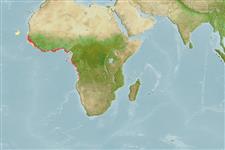>
Carangiformes (Jacks) >
Carangidae (Jacks and pompanos) > Trachinotinae
Etymology: Trachinotus: Greek, trachys, -eia, -ys = rough + Greek,noton = back (Ref. 45335).
More on author: Cuvier.
Environment: milieu / climate zone / depth range / distribution range
Ekologi
marina; brackvatten; djupintervall 0 - 100 m (Ref. 27000). Tropical; 20°N - 20°S
Eastern Atlantic: west coast of Africa, from Senegal to the Congo estuary (Ref. 57392).
Size / Vikt / Age
Maturity: Lm ? range ? - ? cm
Max length : 60.0 cm TL hane/ej könsbestämd; (Ref. 57392); common length : 30.0 cm TL hane/ej könsbestämd; (Ref. 2683)
Taggstrålar i ryggfenan (totalt): 7; Mjukstrålar i ryggfenan (totalt): 20-23; Taggstrålar i analfenan 3; Mjukstrålar i analfenan: 18 - 21. Diagnosis: body short and deep (its depth 1.8-2.6 times in fork length), lozenge-shaped and strongly compressed; front of head arched; snout rounded; upper jaw extending almost to below hind margin of eye; 11-13 gill rakers on lower limb of first gill arch (Ref. 57392). 2 dorsal fins, 1st with 6 spines, 2nd with 1 spine and 20-23 soft rays; anal fin with 2 short, detached spines followed by 1 spine and 18-21 soft rays (Ref. 57392, 81654). Lobes of soft dorsal and anal fins strongly developed and falcate, longer than head at sizes over 10 cm (Ref. 57392), dorsal fin lobe 1.8-3.2 times in fork length (Ref. 81654). Pectoral fins shorter than head; scales small, cycloid and partially embedded in skin; lateral line scarcely arched over pectoral fins, without scutes (Ref. 57392). 4-6 (usually 5) black spots distributed all along lateral line (in specimens longer than 7-9 cm fork length) (Ref. 57392, 81654).
Coloration: back greenish, sides silvery, with 4-6 (usually 5) dark spots regularly spaced along lateral line, 1st as a vertical line, others oval to circular and becoming progressively smaller backwards; dorsal- and anal-fin lobes dark, caudal fin dark, but light-edged distally; these spots absent or indistinct in juveniles smaller than 100 mm (Ref. 57392).
Coastal marine species (Ref. 2683, 57392) occurring down to 100 m depth (Ref. 57392), frequently entering estuaries (Ref. 2683, 57392) and ascending lower courses of rivers (Ref. 57392). Maximum length possibly up to 100 cm (Ref. 57392).
Life cycle and mating behavior
Könsmognad | Reproduktion | Lek | Ägg | Fecundity | Larver
Smith-Vaniz, W.F. and F.H. Berry, 1981. Carangidae. In W. Fischer, G. Bianchi and W.B. Scott (eds.) FAO species identification sheets for fishery purposes. Eastern Central Atlantic (fishing areas 34, 47 (in part) . Vol. 1. (Ref. 3195)
IUCN Red List Status (Ref. 130435)
Threat to humans
Harmless
Human uses
Fiskeri: mindre kommeriell
Ytterligare information
PopulärnamnsynonymerMetabolikPredatorerEkotoxikologiReproduktionKönsmognadLekSpawning aggregationFecundityÄggEgg development
referenserVattenbrukVattenbruksprofilAvelslinjerGenetikElectrophoresesÄrftlighetSjukdomarBehandlingNutrientsMass conversion
Verktyg
Special reports
Download XML
Internet-källor
Estimates based on models
Preferred temperature (Ref.
123201): 19.2 - 28, mean 26.2 °C (based on 100 cells).
Phylogenetic diversity index (Ref.
82804): PD
50 = 0.5000 [Uniqueness, from 0.5 = low to 2.0 = high].
Bayesian length-weight: a=0.01660 (0.00737 - 0.03739), b=2.76 (2.58 - 2.94), in cm total length, based on LWR estimates for this species & Genus-body shape (Ref.
93245).
Trofisk nivå (Ref.
69278): 3.7 ±0.5 se; based on size and trophs of closest relatives
Resiliens (Ref.
120179): Mellan, lägsta populationsfördubblingstid 1,4-4,4 år (Preliminary K or Fecundity.).
Fishing Vulnerability (Ref.
59153): Moderate vulnerability (44 of 100).
Nutrients (Ref.
124155): Calcium = 120 [53, 258] mg/100g; Iron = 1.39 [0.74, 2.96] mg/100g; Protein = 19.1 [17.1, 21.2] %; Omega3 = 0.23 [0.12, 0.45] g/100g; Selenium = 49.9 [21.8, 111.1] μg/100g; VitaminA = 10.3 [2.6, 37.9] μg/100g; Zinc = 0.987 [0.635, 1.556] mg/100g (wet weight);
